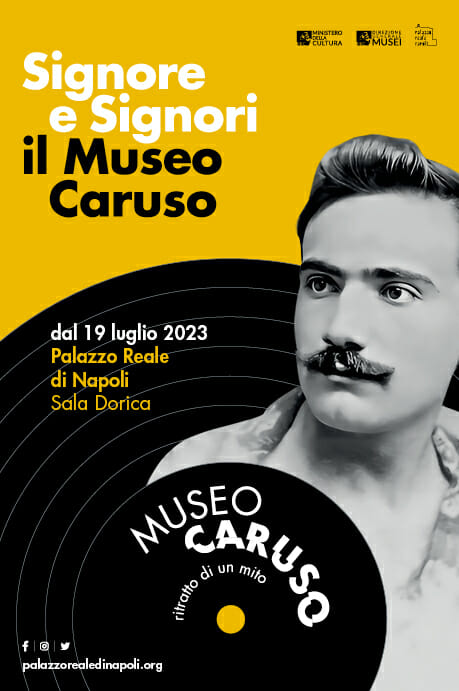19/7/2023
A museum dedicated to Enrico Caruso
The Archive is institutional partner of the first national museum about the great tenor.
On the occasion of the 150th anniversary of the birth of Enrico Caruso, one of the most important tenors of all time, the first national museum dedicated to the artist, curated by Laura Valente, opened inside the Palazzo Reale in Naples on July 20. A single large space, the monumental Sala Dorica, hosts not just an exhibition of memorabilia but a veritable room of wonders, with 3D animations and multimedia platforms, music and film stations and installations, a kaleidoscope of effects aimed at children as well as enthusiasts, insiders and visitors from all over the world.
Archivio Storico Ricordi, institutional partner of the museum, contributed to the installation through numerous reproductions from its collections, particularly musical manuscripts and original photographs. Images portraying Enrico Caruso as a performer, during his travels or in his free time, but also pages from Ricordi magazines (Musica e Musicisti and Ars et Labor), autographs of the romances dedicated to him by the most famous composers of the time (Francesco Paolo Tosti, Luigi Denza, Pier Adolfo Tirindelli) and pages from the letter-copies (the sending of the score of Fanciulla del West to study the part and of which Dick Johnson will be the first or the telegram sent to his family members upon his death). The material provided in digital format was also reproduced in the exhibition catalog, thanks to the curatorial support of archivist and conservator Maria Pia Ferraris, who describes the tenor’s presence in the Archive as follow:
The Enrico Caruso present in the Archivio Storico Ricordi in Milan is not only the great tenor that the music publisher from Milan would like to have as a performer in the most important premieres, because his stage presence is a guarantee of success beyond the value of the opera.
He is not only the undisputed star of the Metropolitan premiere of Puccini’s Girl, that Dick Johnson in the 1910 Fanciulla del West beside Emily Destinn. He is not only the perfect Pinkerton in the London premiere of Madama Butterfly in 1905 or the “usually extraordinary Des Grieux”- words of Giacomo Puccini himself – at the New York premiere of Manon Lescaut in 1907.
The Enrico Caruso in the Archive is also the generous tenor who participates by singing in the Rigoletto Quartet, conducted by Arturo Toscanini, at the gala evening at the MET to raise funds to help Parisians affected by the vast flood of January 1910.
Caruso in the Archive is also the friend of Francesco Paolo Tosti, one of the most famous authors of romances, still sung all over the world. Whenever he travels to London he meets him, joking with him in front of the photographer’s lens. In their turn, Tosti, Luigi Denza, Pier Adolfo Tirindelli – all authors published by Ricordi – dedicated their melodies to him, which he recorded on those first discs, which spread Italian and especially Neapolitan music throughout the world. It is thanks to him that even Gabriele D’Annunzio became a “Neapolitan” lyricist and wrote the famous ‘A Vucchella, set to music by Tosti and recorded four times by Caruso, who made it very famous in America.
Caruso is a legend. Every occasion is good for Ricordi to publish in its magazines news and photos of the tenor whether he is leaving for America or having dinner after a success on the world’s most important stages, to the delight of readers who are great fans of the tenor.
Until the day when the words of an article dedicated to him are no longer written, but those of a telegram sent by the managers of Casa Ricordi – Carlo Clausetti and Renzo Valcarenghi – to the Caruso family at the Hotel Vesuvio in Naples, on August 3, 1921: “All the sources of singing seem to us extinct with the untimely death of the glorious artist who for so many years made the name of Italy vibrate in the world.”
More info: Museo Caruso
